Llamasery's Not The Right Word
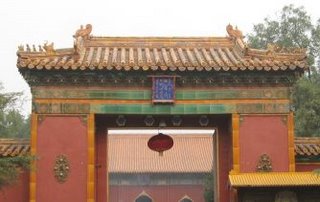
Hello, everyone! I went to another historical site today: Yonghe Gong, the famous Tibetan 'Lamasery' in Beijing. I wish I could go to another famous site tomorrow, but I've got too much studying to do. Before I talk about that, I need to mention that I saw someone with a BlackBerry device yesterday. I learnt that the device had been purchased in England, but that the device was considered by the person who purchased it to be the most reliable and robust of the phones available, even if it's a bit thicker than other phones. Kudos!
My Gretag-Macbeth Colour Checker was unhappy about being forgotten in my room yesterday when I went to Yuanming Yuan, so I was told to bring him to Yonghe Gong. Today I had planned to meet Ali, a good friend of mine from Waterloo who is teaching in another part of Haidian district, at 9:00 for that we could arrive early and perhaps avoid crowds. Because of some miscommunication on my part,we didn't meet until after 10:30. I'm sorry for the trouble Ali had; I, however, was given time to write a few post cards which I'll be able to post on Monday. While I awaited Ali's arrival, I had to use the washroom. While I was washing my hands, I saw a wonderful sign above the sink.
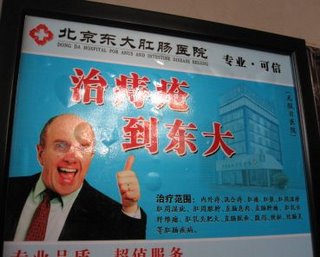 Why is this man so happy?
Why is this man so happy?Ah, I understand, now
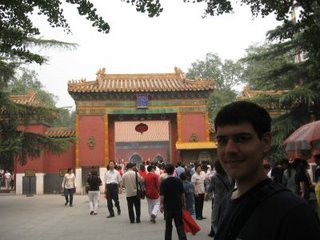
Ali in front of the main gate

Me, my paunch, and the Gretag-Macbeth Colour Checker
I've got a few things to say about Tibetan Buddhism, and also about this 'lamasery'. I would like to follow Donald Lopez's lead on this by decomposing my account into seven sections mirroring those in his book Prisoners Of Shangri-La, but I am afraid that I have little to say about several sections.
The Name
Okay, let me set a few things straight. Firstly, the compound has the name Yonghe Gong because it was once the palace of the Qing-dynasty prince-who-became-emperor Yongzheng. After he became emperor, he turned his palace (his 'gong') into a Tibetan temple. Secondly, the term 'lamasery' is a bit of a misnomer because not all monastics in the Tibetan tradition are lamas, and my understanding is that not all lamas are monastics. Of course, they should not be confused with those hairy mammals from South America, the name of which has been corrupted in its anglicised form to be homophonous to 'lama'.
The outsides of the buildings are really beautiful; I didn't have a chance to see their insides, for the most part. The buildings of which I saw the insides were filled with ash from the large amount of incense burnt.
The Spell
Ali and I saw some large prayer wheels at different parts of the temple. Many prayer wheels have mantras printed on the outside (and on the inside); most have 'om mani padme hum', the exact meaning of which has been debated for centuries. For a great exposition on this topic, I highly recommend Lopez's Prisoners Of Shangri-La (ISBN 0-226-49311-3).
The first westerner thought to have encountered that term was a Dutch Franciscan monk whose anglicised name is William of Rubruck, when he visited Mongke Khan's court at Shangtu (Xanadu, Shangdu 上都). His romanisation was 'o mani baccam', and he was told that it meant something akin to giving praise to God. Other westerners who had early encounters with Tibetan Buddhism include Marco Polo and a Jesuit named Ippolito Desideri. In his book, Desideri gave a limited account of the Chinese invasion of Lhasa in 1721, which marked the end of his five-year stay in Tibet. His account of Tibetan Buddhist religious practices is top-notch, and was remarkably dispassionate for his time.
The Gretag-Macbeth Colour Checker, being a man of his own, insisted on having his photo taken with one of the prayer wheels, so I consented.
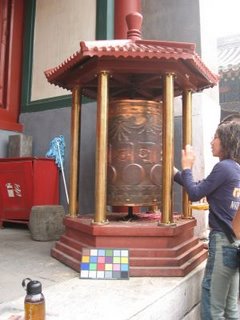
Om Mac Beth Hum
The Art
I saw a sinicised statue of Maitreya, the buddha of the next age, in the first building which I entered, along with a number of other sinicised Buddhist icons. I found neither the bronze statue of Tsong Khapa, the founder of the Gelukpa sect of Tibetan Buddhism, nor the statue carved from a single piece of sandalwood of Maitreya. I was tired of trying to push my way through buildings (we arrived quite late in the morning), so I may take another trip in the future to see these statues.
Wrap-up
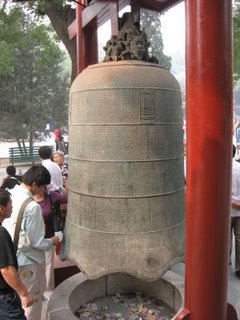 Some visitors trying to ring some changes with some pocket-change
Some visitors trying to ring some changes with some pocket-change
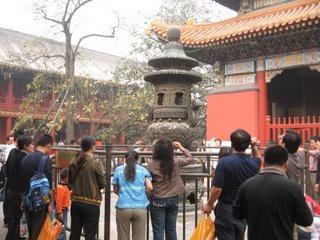 Other visitors throwing money, as in a game
Other visitors throwing money, as in a game

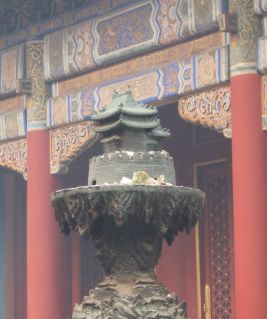

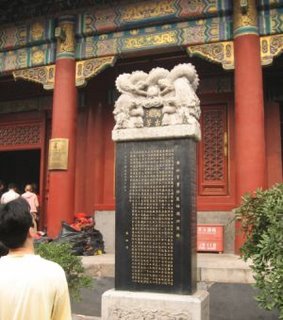 Thus Spake Avalokitesvara
Thus Spake Avalokitesvara


4 Comments:
On our visit to Beijing this past Aug we went to a Taoist monastery/temple/college (not quite clear on that) in the city itself. One of the few Taoist training centers to survive the upheaval of the recent decades. S2, since you seem to be pretty knowledgeable about east asian religions, I'll have to get you to explain to me what Taoism is about one of these days. The person I was with who seemed a little more knowledgable about it said something like 'if you understand it then you haven't really understood it' :)
Hello, Shanmao.
Yeah, one of the ideas in Daoism (notice that I'm using the Pinyin 'Dao', and not the Wade-Giles and Yale 'Tao') is that the universe holds certain truths which are beyond description using language, just like in every other major religion. By living a certain type of life, one of ceratin types of non-interference, one may come to know the Dao. If one believes that one can describe the Dao, then one does not understand it. 'The Dao which can be described is not the true Dao.' The rest is commentary. ;)
Of course, Daoism's not my current focus in my Religious Studies degree, Chinese Buddhism is. If anyone who reads these comments thinks that I'm off-base or hasmore to contribute to my Rabbi Hillel-esque standing-on-one-leg description, please do so. :D
Ive heard of the monastery / temple / college to which you made reference. My understanding is that any monastery is a temple, and that this one serves as a college. Of course, monasteries for faiths which have them have traditionally served as colleges, after a fashion, for novitiates, with some monasteries having more of a focus on academics and philosophy than others.
I'm surprised that it would be a visitor to China who would be the first Westerner to encounter the phrase "om mani padme hum", since it's apparently revered in Hinduism as well. Naively, I would've thought they'd have been in India earlier and heard it there.
Hello, Wondershaft.
I followed your link to Wikipedia's entry (this is the first time any link to Wikipedia has worked for me in China). The entry has nothing other than a brief mention of a connection to Hinduism; the page itself only cites references to Mahayana and Vajrayana Buddhism. I know nothing of the mantra's connections to Hinduism; I don't remember what Lopez has to say about that, and I don't have access to any copy of the book. William of Rubruck went to that court in approximately 1250, long before someone from Western Europe has been documented to have gone to 'Hindustan'.
As with any entry in the Wikipedia, your mileage may vary ....
Post a Comment
<< Home